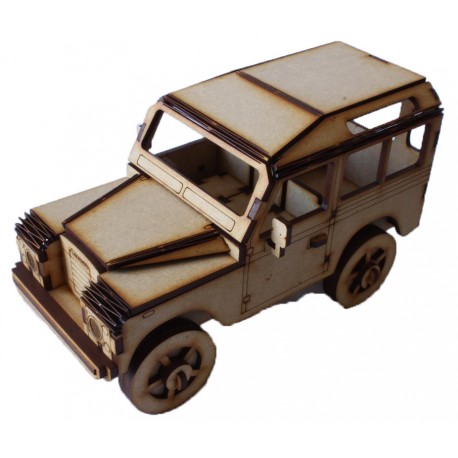No products
 View larger
View larger
Land Rover Series 3 3D Puzzle
Land Rover Series 3 3D Puzzle
New product
This Land Rover Series 3 3D Puzzle is recommended for children of 7 years and older.
No Glue is Required for assembly
Build Size :210x110x115mm (Length X With X Height)
Pieces : 56
Instructions for assembly can be found in the download section under "more" if required.
17 Items
In Stock
More info
This Land Rover Series 3 3D Puzzle is recommended for children of 7 years and older.
Build Size :210x110x115mm (Length X With X Height)
Pieces : 56
No Glue is Required for assembly
The Basics
All the pieces of the puzzles slot into each other so the puzzle can be rebuilt as many times as you wish without glue. However, if you would like to display it on a shelf or in a cabinet we would recommend a bit of wood glue to keep it secure over a long period of time. The puzzles are made from wood so they can be painted with normal acrylic paint or spray paint.
The puzzles do not come with instructions. The reason behind this is because it is a puzzle… and the fun part is trying to figure out how all the pieces fit together as you would with a normal picture puzzle; so hours of fun can be had with the entire family joining in. But please do not fear as help is only an email away. Contact Xplore Designs via an email and we will gladly send you instructions to help you and assist in any way we can.
Some Interesting Information
The successor to the successful Series I was the Series II, which saw a production run from 1958 to 1961. It came in 88 in (2,200 mm) and 109 in (2,800 mm) wheelbases (normally referred to as the 'SWB' and 'LWB'). This was the first Land Rover to receive the attention of Rover's styling department- Chief Stylist David Bache produced the familiar 'barrel side' waistline to cover the vehicle's wider track and the improved design of the truck cab variant, introducing the curved side windows and rounded roof still used on current Land Rovers. The Series II was the first vehicle to use the well-known 2.25-litre petrol engine, although the first 1,500 or so short wheelbase (SWB) models retained the 52 hp (39 kW) 2.0-litre petrol engine from the Series I. This larger petrol engine produced 72 hp (54 kW) and was closely related to the 2.0-litre diesel unit still in use. This engine became the standard Land Rover unit until the mid-1980s when diesel engines became more popular.
The 109-inch (2,800 mm) Series II Station Wagon introduced a twelve-seater option on top of the standard ten-seater layout. This was primarily to take advantage of UK tax laws, by which a vehicle with 12 seats or more was classed as a bus, and was exempt from Purchase Tax and Special Vehicle Tax. This made the twelve-seater not only cheaper to buy than the 10-seater version, but also cheaper than the seven-seater 88-inch (2,200 mm) Station Wagon. The twelve-seater layout remained a highly popular body style for decades, being retained on the later Series and Defender variants until 2002, when it was dropped. The unusual status of the twelve-seater remained until the end—such vehicles were classed as minibuses and thus could use bus lanes and (if registered correctly) could be exempt from the London Congestion Charge.
There was some degree of over-lap between Series I and Series II production. Early Series II 88-inch (2,200 mm) vehicles were fitted with the old 2-litre petrol engine to use up existing stock from production of the Series I 107-inch (2,700 mm) Station Wagon continued until late 1959 due to continued demand from export markets and to allow the production of Series II components to reach full level.

